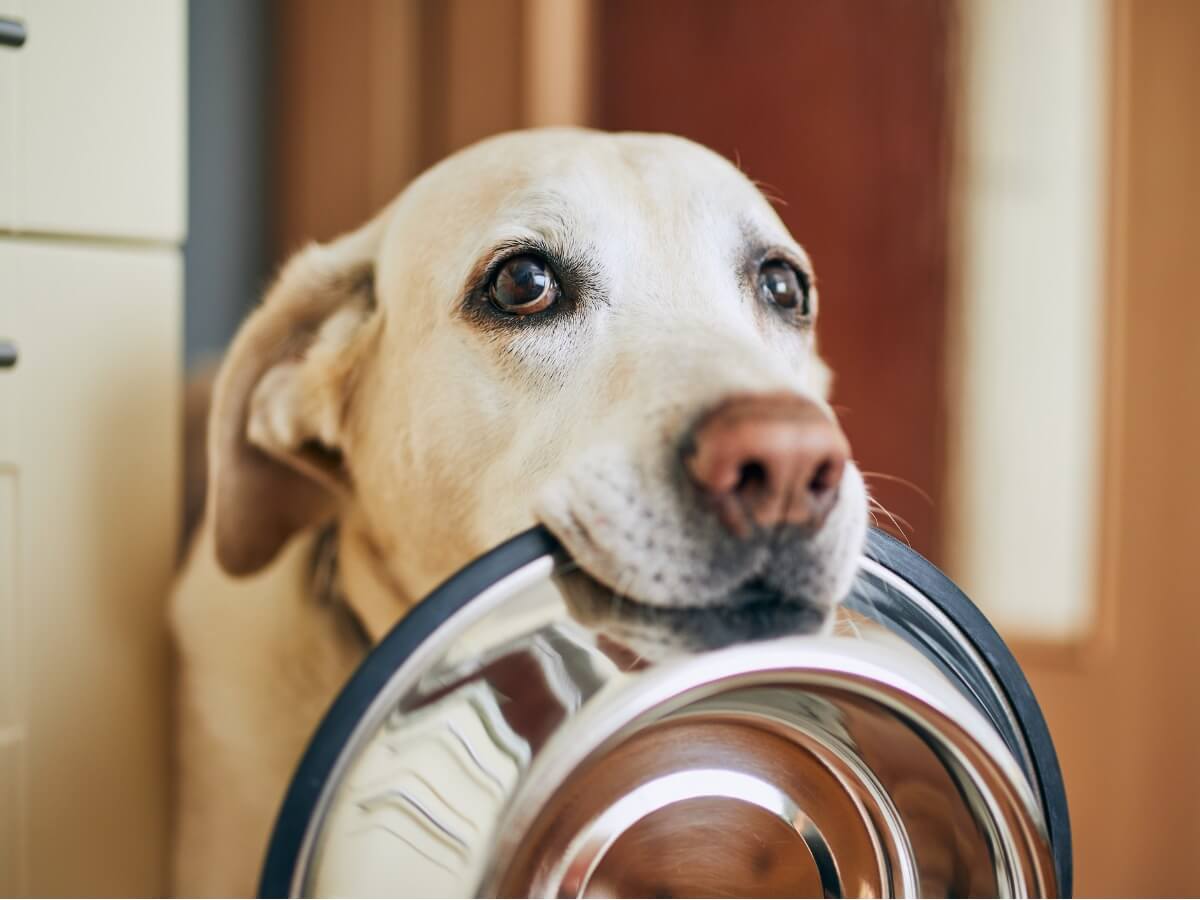7 Things You Do that Can Shorten Your Dog's Life

Anyone who undertakes to look after an animal wants it to live happily and for many years. However, without realizing it, you may be unintentionally doing things that shorten your dog’s life.
That’s exactly what we’re going to talk about in this article. Actions that, if their effect is unknown, have a negative impact on the dog’s health and, consequently, shorten its life expectancy. Don’t miss them, because it is never too late to improve the care you give your dog.
Things you do unintentionally, but which shorten your dog’s life
A well-cared-for dog can live 15 years, even more in certain cases. However, this figure isn’t the result of chance, but is the result of good care that shouldn’t be forgotten throughout the animal’s life. Let’s take a look at some habits that should be avoided in this regard.
1. Feeding them poorly

We are what we eat, whether we’re human or animals. Vets insist a lot in this respect, because you don’t only control an animal’s weight in this way. The composition of a dog’s food balances their overall health, thus preventing future problems such as cardiovascular disease, diabetes, or dental disease.
On average, a healthy, whole adult dog should consume 18% protein and 5% fat in its daily diet.
It’s logical that your dog will ask for what you have on your plate. It smells good and you’re eating it, so he’ll want you to share. Although they’re specialists in softening your heart, be consistent with their training in this regard, as many of the components of your food aren’t suitable for canines. Giving in to their whims will only have a negative effect on their body in the long term.
2. Not cleaning them properly
Although it’s true that dogs groom themselves, you shouldn’t forget that not washing them is one of the things that can shorten your dog’s life. Each dog needs its own bathing frequency depending on its coat and lifestyle. Don’t forget that their nails, ears, and teeth also require specialized care.
Without proper hygiene, parasitosis and infection problems often appear.
3. Not taking them for walks
A dog that doesn’t exercise regularly will begin to deteriorate at approximately 5 years of age. Dogs, like any other animal, need to move, expend energy, and go out. Not doing so is detrimental to both their physical and mental health, as the stimulation they receive on the street can’t compare to the stimulation they get at home, which is much more limited.
4. Not training them or helping them to socialize
Now that many people opt for adoption, it’s easy to find cases of animals that have been mistreated or who have led an undignified life until they reach their final home. Therefore, many of them will develop behavioral and socialization problems if we don’t intervene.
A dog needs its owner’s guidance in order to learn to coexist with all the species around it, human or not, domestic or wild. Otherwise, the probability of accidents increases and the dog’s mental health deteriorates.
5. Not taking them to their regular check-ups
Another thing you do that can shorten your dog’s life without realizing it is to rely on your own guidance regarding vaccinations, deworming, and check-ups. Following this plan prevents common canine diseases, such as distemper or rabies, as well as protecting against internal or external parasites.
However, there’s something else to keep in mind. When you vaccinate your dog, you aren’t only protecting them, but all other dogs and species susceptible to zoonosis. So, never fail to visit your vet when it’s time.

6. Using chemicals near your dog
Many of the products that are made for household cleaning, cosmetics or garden maintenance, for example, are only made not to intoxicate humans. And, even though you know that you shouldn’t take a sip of bleach, your dog doesn’t.
Even if your dog isn’t the type to play with a bottle of ammonia, always try to keep these products out of their reach. You should also read the labels, as many of them should never be used near them.
7. Creating a stressful environment
Loud noises, fighting, and even lack of stimulation are stress factors for dogs. Maintaining a calm home environment with adequate stimulation for your dog is as important as feeding them a good diet or taking them out for exercise.
As with humans, sadness and stress shorten a dog’s life.
You may find these conditions insignificant on a day-to-day basis (“what’s the problem if they eat a slice of pizza today?”), but the key to extending your dog’s life is consistency. You’re not going to add years to their life in one day, but you can over a period of time. Make sure you don’t neglect their needs.
Anyone who undertakes to look after an animal wants it to live happily and for many years. However, without realizing it, you may be unintentionally doing things that shorten your dog’s life.
That’s exactly what we’re going to talk about in this article. Actions that, if their effect is unknown, have a negative impact on the dog’s health and, consequently, shorten its life expectancy. Don’t miss them, because it is never too late to improve the care you give your dog.
Things you do unintentionally, but which shorten your dog’s life
A well-cared-for dog can live 15 years, even more in certain cases. However, this figure isn’t the result of chance, but is the result of good care that shouldn’t be forgotten throughout the animal’s life. Let’s take a look at some habits that should be avoided in this regard.
1. Feeding them poorly

We are what we eat, whether we’re human or animals. Vets insist a lot in this respect, because you don’t only control an animal’s weight in this way. The composition of a dog’s food balances their overall health, thus preventing future problems such as cardiovascular disease, diabetes, or dental disease.
On average, a healthy, whole adult dog should consume 18% protein and 5% fat in its daily diet.
It’s logical that your dog will ask for what you have on your plate. It smells good and you’re eating it, so he’ll want you to share. Although they’re specialists in softening your heart, be consistent with their training in this regard, as many of the components of your food aren’t suitable for canines. Giving in to their whims will only have a negative effect on their body in the long term.
2. Not cleaning them properly
Although it’s true that dogs groom themselves, you shouldn’t forget that not washing them is one of the things that can shorten your dog’s life. Each dog needs its own bathing frequency depending on its coat and lifestyle. Don’t forget that their nails, ears, and teeth also require specialized care.
Without proper hygiene, parasitosis and infection problems often appear.
3. Not taking them for walks
A dog that doesn’t exercise regularly will begin to deteriorate at approximately 5 years of age. Dogs, like any other animal, need to move, expend energy, and go out. Not doing so is detrimental to both their physical and mental health, as the stimulation they receive on the street can’t compare to the stimulation they get at home, which is much more limited.
4. Not training them or helping them to socialize
Now that many people opt for adoption, it’s easy to find cases of animals that have been mistreated or who have led an undignified life until they reach their final home. Therefore, many of them will develop behavioral and socialization problems if we don’t intervene.
A dog needs its owner’s guidance in order to learn to coexist with all the species around it, human or not, domestic or wild. Otherwise, the probability of accidents increases and the dog’s mental health deteriorates.
5. Not taking them to their regular check-ups
Another thing you do that can shorten your dog’s life without realizing it is to rely on your own guidance regarding vaccinations, deworming, and check-ups. Following this plan prevents common canine diseases, such as distemper or rabies, as well as protecting against internal or external parasites.
However, there’s something else to keep in mind. When you vaccinate your dog, you aren’t only protecting them, but all other dogs and species susceptible to zoonosis. So, never fail to visit your vet when it’s time.

6. Using chemicals near your dog
Many of the products that are made for household cleaning, cosmetics or garden maintenance, for example, are only made not to intoxicate humans. And, even though you know that you shouldn’t take a sip of bleach, your dog doesn’t.
Even if your dog isn’t the type to play with a bottle of ammonia, always try to keep these products out of their reach. You should also read the labels, as many of them should never be used near them.
7. Creating a stressful environment
Loud noises, fighting, and even lack of stimulation are stress factors for dogs. Maintaining a calm home environment with adequate stimulation for your dog is as important as feeding them a good diet or taking them out for exercise.
As with humans, sadness and stress shorten a dog’s life.
You may find these conditions insignificant on a day-to-day basis (“what’s the problem if they eat a slice of pizza today?”), but the key to extending your dog’s life is consistency. You’re not going to add years to their life in one day, but you can over a period of time. Make sure you don’t neglect their needs.
All cited sources were thoroughly reviewed by our team to ensure their quality, reliability, currency, and validity. The bibliography of this article was considered reliable and of academic or scientific accuracy.
- Overweight Dogs and Cats: Pet Obesity Risks. (2021). Best Friends Animal Society. https://resources.bestfriends.org/article/overweight-dogs-and-cats-pet-obesity-risks
- Breeding, E. (2020, 20 marzo). Consecuencias Mentales del Encierro en Jaulas. Program for Ethical Breeding. https://ethicalbreeding.org/gatos/consecuencias-mentales-del-encierro-en-jaulas/
- Pet Care Information. (2021b). ShareThis. https://resources.bestfriends.org/pet-training-dog-training/common-behavior-issues?page=1
- Barrera, G. (2008, 6 diciembre).Calidad de Vida en Perros Alojados en Refugios: Intervenciones para Mejorar su Bienestar | Barrera | Artículos en PDF disponibles desde 1994 hasta 2013. A partir de 2014 visítenos en www.elsevier.es/sumapsicol. Suma Psicológica. http://publicaciones.konradlorenz.edu.co/index.php/sumapsi/article/view/43
This text is provided for informational purposes only and does not replace consultation with a professional. If in doubt, consult your specialist.








